Friday, February 3
• First-quarter Moon (exact at 11:19 p.m. EST). At sunset the half-lit Moon is high in the south. After dark it balances on the dim head of Cetus. Spot the stars of Aries to its upper right, and the Pleiades a little farther to its upper left.

Saturday, February 4
• In early evening the Pleiades stand above the Moon, and Aldebaran shines left of it, as shown here.
Sunday, February 5
• The waxing gibbous Moon shines left of Aldebaran in twilight for North America, then pulls farther away from it through the night. The Moon occults Aldebaran for southern Europe and northern Africa; map and timetables.
Monday, February 6
• The sky's biggest asterism (informal star pattern) is the Winter Hexagon, and the Moon shines inside it tonight and tomorrow night. Start with brilliant Sirius at the Hexagon's bottom. Going clockwise from there, march through Procyon, Pollux and Castor, Menkalinan and Capella high up, Aldebaran down to Capella's lower right, down to Rigel in Orion's foot, and back to Sirius. Betelgeuse sparkles inside the Hexagon, south of the Moon this evening.
Tuesday, February 7
• After dark look due east, not very high, for twinkly Regulus. Extending upper left from it is the Sickle of Leo, a backward question mark. "Leo announces spring," goes an old saying. Actually, Leo showing up in the evening announces the cold, messy back half of winter. Come spring, Leo will already be high.
Wednesday, February 8
• This evening, the Moon shines on the segment of the Winter Hexagon between Pollux and Procyon.
Thursday, February 9
• Look above the Moon now for Pollux and Castor (Pollux is the lower and brighter of the two, tinted orange). A similar distance right or upper right of the Moon is Procyon.
Friday, February 10
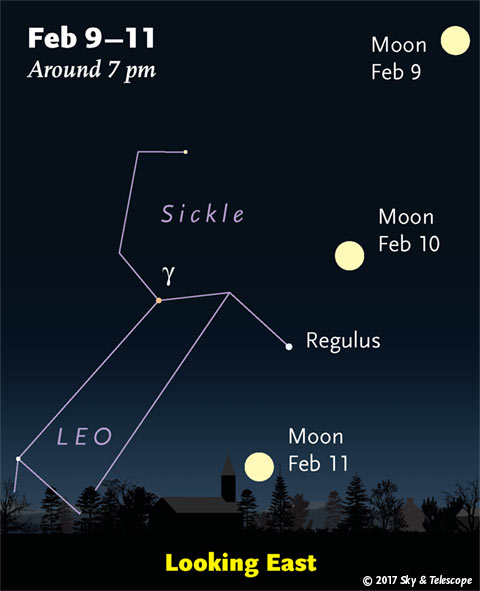
• Full Moon (exactly so at 7:33 p.m. EST). A very deep penumbral eclipse of the Moon is visible around sunset or early evening from most of the Americas; map and details. And see the February Sky & Telescope, page 48.
Look for Regulus 6° or 7° to the Moon's lower left as darkness comes on for North America. By midnight, Regulus is directly to the Moon's left.
Saturday, February 11
• By 9 p.m. or so, the Big Dipper stands on its handle in the northeast. The Pointers, its top two stars, point left toward Polaris. In the northwest, Cassiopeia stands on end at about that same height.
_________________________
Want to become a better astronomer? Learn your way around the constellations! They're the key to locating everything fainter and deeper to hunt with binoculars or a telescope.
This is an outdoor nature hobby. For an easy-to-use constellation guide covering the whole evening sky, use the big monthly map in the center of each issue of Sky & Telescope, the essential guide to astronomy.
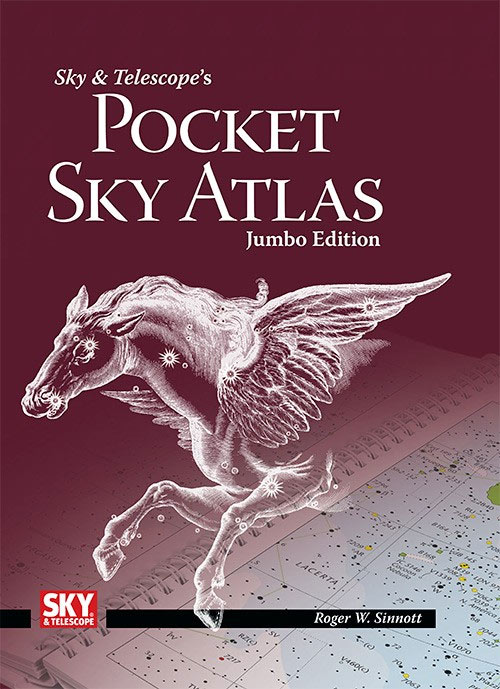
Once you get a telescope, to put it to good use you'll need a detailed, large-scale sky atlas (set of charts). The basic standard is the Pocket Sky Atlas (in either the original or new Jumbo Edition), which shows stars to magnitude 7.6.
Next up is the larger and deeper Sky Atlas 2000.0, plotting stars to magnitude 8.5; nearly three times as many. The next up, once you know your way around, is the even larger Uranometria 2000.0 (stars to magnitude 9.75). And read how to use sky charts with a telescope.
You'll also want a good deep-sky guidebook, such as Sue French's Deep-Sky Wonders collection (which includes its own charts), Sky Atlas 2000.0 Companion by Strong and Sinnott, or the bigger Night Sky Observer's Guide by Kepple and Sanner.
Can a computerized telescope replace charts? Not for beginners, I don't think, and not on mounts and tripods that are less than top-quality mechanically (meaning heavy and expensive). And as Terence Dickinson and Alan Dyer say in their Backyard Astronomer's Guide, "A full appreciation of the universe cannot come without developing the skills to find things in the sky and understanding how the sky works. This knowledge comes only by spending time under the stars with star maps in hand."
This Week's Planet Roundup
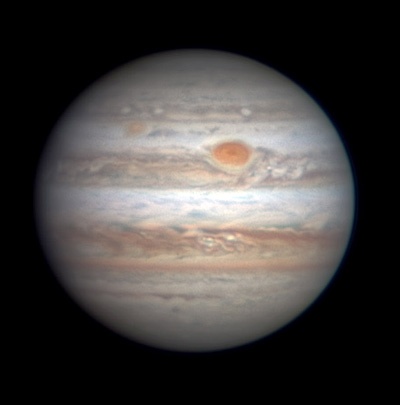
Mercury (still magnitude –0.2) is sinking ever lower down into the glow of dawn. Use binoculars to try for it 20 or 30 minutes before sunrise, barely above the east-southeast horizon. It moves from 30° to 40° lower left of Saturn this week. Good luck.
Venus dazzles high in the southwest during twilight, then lower in the west after dark until setting around 9 p.m. All February it's at its peak brightness, magnitude –4.8. To its upper left is tiny orange Mars, only 0.5% as bright.
In a telescope Venus is less than half sunlit. It's growing larger as it approaches us, now about 34 arcseconds from cusp to cusp. For the rest of the winter Venus will continue to enlarge as its phase wanes down to a thin crescent.
Venus in a telescope is least glary when viewed in bright twilight. So get your scope on it as soon as you can see it naked-eye, even before sunset.
Mars (magnitude +1.1) is the faint "star" upper left of Venus. They're 6° apart this week, soon to start widening. In a telescope Mars is just a tiny fuzzblob 5 arcseconds wide.
Vesta, the brightest asteroid, is still a very accessible magnitude 6.6 in Gemini near Pollux and Castor. Article and finder chart.
Jupiter (magnitude –2.2, in Virgo) rises around 11 p.m. and shines brightly high in the south in the hours before dawn. Spica dangles 3½° lower right of it after the rise, and more directly below it before dawn. Jupiter is creamy white. Spica is an icier shade of white with a trace of blue (once it's fairly high).
In a telescope Jupiter is 40 arcseconds across its equator, on its way to 44 arcseconds in late March and April. It will reach opposition on April 7th.
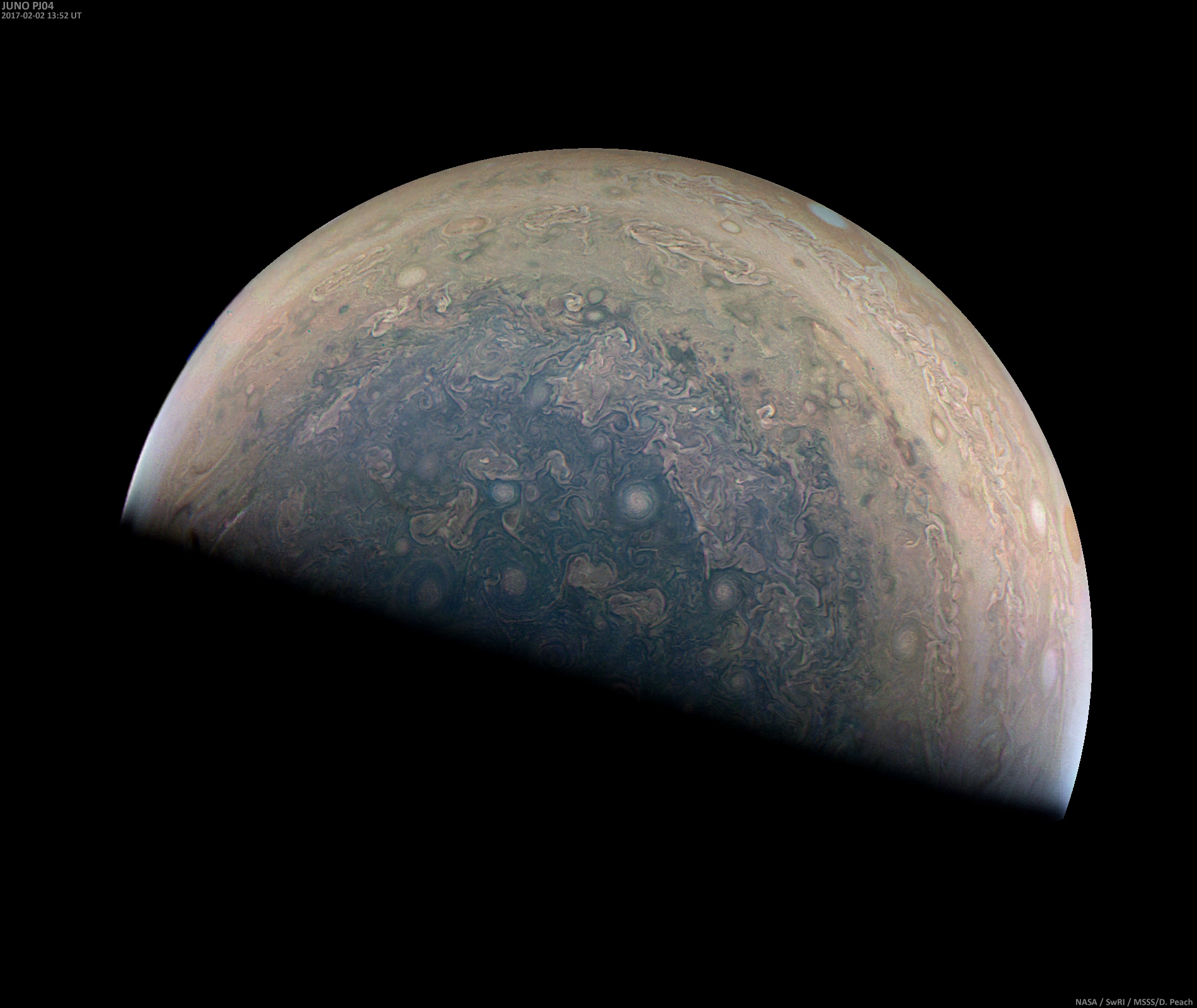
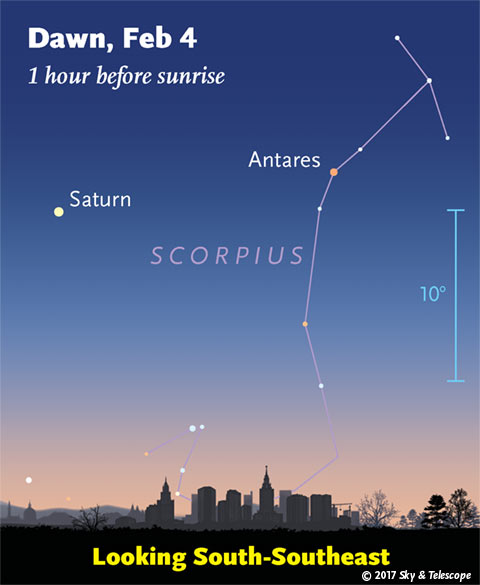
Saturn (magnitude +0.5, in southern Ophiuchus) is in the southeast before and during dawn. Redder Antares, magnitude +1.0, twinkles 16° to Saturn's right, as shown here.
Uranus (magnitude 5.8, in Pisces) is still fairly well up in the southwest right after dark. Finder chart.
Neptune is getting lost low in evening twilight.
__________________________
All descriptions that relate to your horizon — including the words up, down, right, and left — are written for the world's mid-northern latitudes. Descriptions that also depend on longitude (mainly Moon positions) are for North America.
Eastern Standard Time (EST) is Universal Time (UT, UTC, or GMT) minus 5 hours.
__________________________
"This adventure is made possible by generations of searchers strictly adhering to a simple set of rules. Test ideas by experiments and observations. Build on those ideas that pass the test. Reject the ones that fail. Follow the evidence wherever it leads, and question everything. Accept these terms, and the cosmos is yours."
— Neil deGrasse Tyson, 2014
"Objective reality exists. Facts are often determinable. Science and reason are no political conspiracy; they are how we discover objective reality. Civilization's survival depends on our ability, and willingness, to do this."
— Alan MacRobert, your Sky at a Glance editor
"Facts are stubborn things."
— John Adams, 1770
March For Science on April 22nd, to “champion publicly funded and publicly communicated science as a pillar of human freedom and prosperity.”
 3
3








Comments
Anthony Barreiro
February 3, 2017 at 4:26 pm
Thanks for publicizing the March for Science, Alan. It's a shame that we have to state the obvious, that publicly funded and publicly communicated science is a benefit to all. But the times require it.
You must be logged in to post a comment.
cheeks
February 7, 2017 at 4:03 pm
How do I create a desktop icon for Sky and Telescope? I want to monitor the nightly sky. I have Windows 10.
Thanx
You must be logged in to post a comment.
mary beth
February 8, 2017 at 10:34 am
Try this! http://www.thewindowsclub.com/create-website-shortcuts-windows-desktop. Hope this helps
You must be logged in to post a comment.
You must be logged in to post a comment.